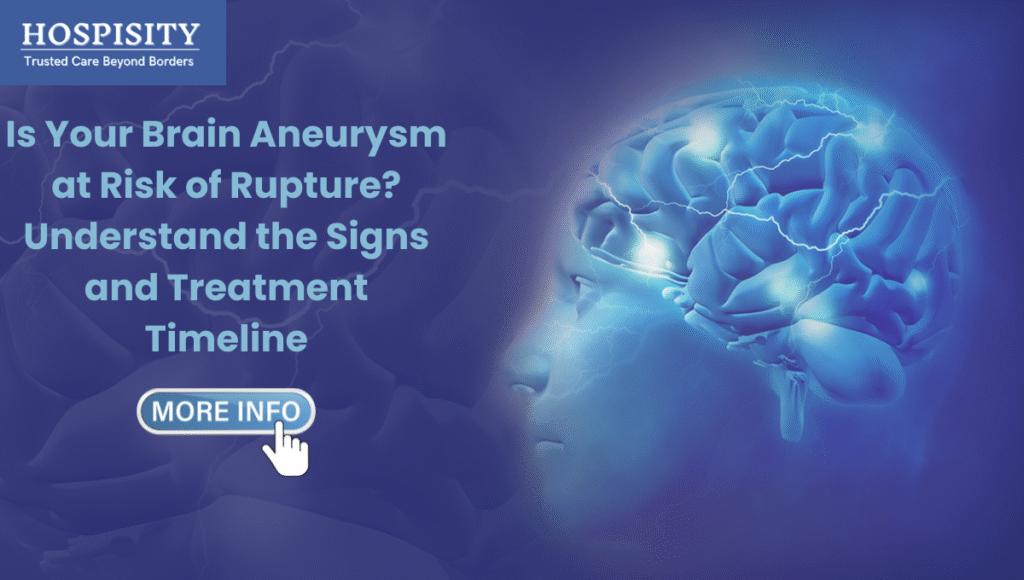Is Your Brain Aneurysm at Risk of Rupture? Understand the Signs and Treatment Timeline

A brain aneurysm is a weak bulge in a cerebral artery that can dangerously rupture and cause hemorrhagic stroke. Early detection and timely treatment are key. India offers advanced treatment options microsurgical clipping, endovascular coiling, flow-diversion and world-class neurosurgical care at significantly lower costs. Here’s what you should know to protect your health.
According to neurology guidelines, several key factors predict rupture risk
Aneurysm size: > 7 mm carries higher risk; posterior circulation or large size further increases danger
Location: Posterior or vertebrobasilar arteries are more prone to rupture
Family history: Especially with conditions like polycystic kidney disease
Individual risks: Hypertension, smoking, heavy alcohol, stimulant drugs, age > 50, female gender
⚠️ Warning Signs: When to See a Neurosurgeon
Most small aneurysms are silent. But seek immediate medical attention if you experience:
Sudden, severe “thunderclap” headache “worst of your life”
Nausea, vomiting, neck stiffness, confusion
Vision changes, double vision or facial pain
Seizure, sudden weakness on one side
If symptoms like these occur, a ruptured aneurysm is a medical emergency time is critical.
📏 Diagnosing & Monitoring Brain Aneurysms
Diagnostic Imaging:
CT/CT Angiography: Quick detection of bleeding
MRI/MR Angiography: Ideal for unruptured or small aneurysms
Digital Subtraction Angiography (DSA): Gold standard for 3D vessel evaluation
Monitoring Schedule:
Small (< 6 mm): Imaging every 6–24 months
Large or symptomatic: More frequent imaging
🛡️ When to Treat: Intervention Criteria
Consider treatment for aneurysms that:
Are >7 mm, growing, or located in risky areas
Belong to patients with high blood pressure, smoking, connective tissue disorders
Have symptomatic signs like headaches or cranial nerve issues
Are suitable candidates for endovascular or microsurgical options
🏥 Advanced Treatment Options in India
1. Microsurgical Clipping
Open craniotomy to clip the aneurysm neck
Ideal for large, complex shapes
Cost: USD 7,000–8,500 (~₹ 5.5–6.5 L) Precision ensured by hybrid OR and neuronavigation
2. Endovascular Coiling
Minimally invasive: platinum coils induce clotting
Typically done via femoral catheter under fluoroscopy
Cost: USD 9,000–11,500 (~₹ 7–9 L)
Lower blood loss and faster recovery
3. Flow Diversion (Stent)
Newer method using mesh stents (e.g. Pipeline)
Redirects blood flow and promotes vessel healing
Often more cost-effective than coiling overall
Cost: USD 9,000–11,500 (~₹ 7–9 L)
📊 Cost Comparison of Aneurysm Treatments in India
| Treatment | Cost (USD) | INR Equivalent |
|---|---|---|
| Microsurgical Clipping | 7,000 – 8,500 | ₹5.5L – 6.5L |
| Endovascular Coiling | 9,000 – 11,500 | ₹7L – 9L |
| Flow Diversion | 9,000 – 11,500 | ₹7L – 9L |
India offers 70% cost savings versus US/UK, without compromising on care or outcomes
Top Hospitals in India for Brain Aneurysm Repair Surgery
Fortis Hospital, Gurgaon
Fortis Escort Heart Institute, New Delhi
Medanta – The Medicity, Gurgaon
Max Super Speciality Hospital, Delhi
Artemis Hospital, Gurgaon
Shalby Sanar Hospital, Delhi NCR
Fortis Hospital, Bangalore
Jaslok Hospital, Mumbai
Apollo Proton Hospital, Chennai
Indraprastha Apollo Hospital, Delhi
Manipal Hospital, Delhi
🏥 Why Choose India for Aneurysm Repair?
Highly skilled neurovascular teams using digital subtraction angiography, 3D imaging, hybrid ORs
Short wait times even for urgent cases
Accredited hospitals (NABH & JCI) ensuring global standards
Complete support: visa, airport pickup, lodging, translators, and rehab coordination
Transparent pricing and affordable care packages
🛡️ Post-Treatment Monitoring & Follow-Up
First imaging at 3–6 months, then at 1 year
Ongoing scans at 3–5 years to detect recurrences
Regular BP and lifestyle management to reduce future risk
✅ Who Should Consider Early Treatment?
Aneurysm >7 mm, growing, or in high-risk location
Additional risk with hypertension, smoking, or family history
Symptoms like headache, vision changes, or seizures
Past aneurysm rupture or connective tissue conditions
⚖️ Weighing Risks vs. Benefits
All procedures carry risks like bleeding, infection, or vessel injury, but India’s success rates are above 95%, with mortality under 2%. Flow diversion generally has lower retreatment costs versus coiling.
Final Thoughts
If you suspect an aneurysm or already have a diagnosis, don’t delay. With advanced medical options, cost-effective care, and expert neurosurgical support in India, you can reduce rupture risk and get back to living well.
Let HOSPISITY guide your journey from diagnosis and treatment selection to surgery and rehabilitation.
